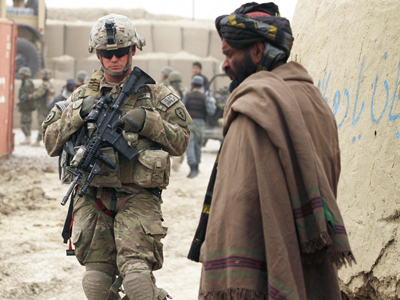
The Americans have made their alliance partners wait once again — as they have repeatedly in the 14-year history of involvement in Afghanistan — with their habit of abruptly changing decisions and strategies concerning troop strength and operational scope without prior consultation with anyone. President Obama will keep 9,800 troops in Afghanistan through the end of 2016, one year longer than previously planned. Neither will the scope of the operation remain restricted to Kabul, as had been originally planned. Troop strength will be reduced to 5,500 in 2017, but President Obama made no mention of any date for a complete withdrawal.
The German army has been engaged in the Hindu Kush since the end of 2001 with a troop strength varying between a high of 8,000 to the current 890 soldiers. True to the NATO motto “In together, out together,” the German contingent will also now remain longer than previously thought. The earliest withdrawal possible is now 2017, but later than that is also a possibility, according to a spokesperson from the German Foreign Office.
One might reasonably suspect that Obama’s decision to stay in Afghanistan — a deployment that meanwhile has lasted three times longer than World War II (!) — has more to do with the American election calendar than it does with an honest belief that staying will ultimately result in victory. To face a bitterly contested election and be incapable of keeping his election promises, or to be forced to turn his back on Afghanistan as he did in Iraq with his strategy of “leading from behind” and then have to witness the country sink into death and destruction on the eve of a presidential election in November, would not be his first choice. He doesn’t want to hear the accusation “After Iraq, you lost Afghanistan, too.” There’s more election strategy here than military.
But let’s not delude ourselves. The illusionary bubble that Afghan security was capable of dealing with the terrorists has burst in the past few weeks. The fall of Kunduz — for many years the largest city that was formerly the tactical responsibility of the German military and where the German army once had troops stationed — showed that the Afghans weren’t up to the task. A 7,000-man garrison was incapable of defending the city against a Taliban attack. It took two days to retake the city with the help of the U.S. Air Force, during which action the unfortunate error of bombing the Doctors Without Borders hospital took place.
NATO military closed its eyes to reality. Gen. John Campbell, commander of U.S. forces in Afghanistan, testified before the Senate: “The Afghan security forces have displayed courage and resilience. They’re still holding. The Afghan government retains control of Kabul, of Highway One, its provincial capitals and nearly all of the district centers.” In the same vein, German Army Gen. Andreas Hannemann, commander of international forces in the north, said he was confident the Afghans were capable of defending their own country.
Reports by the United Nations Assistance Mission in Afghanistan read distinctly otherwise. According to those reports, traffic on National Route 1, a ring highway that connects Afghanistan’s major cities, is repeatedly blocked by the Taliban. In 186 of the 376 districts, the government controls only the beleaguered local telephone exchange. The Afghan president reports that in 13 of the 34 provinces, firefights have taken place during the past six months. In 27 provinces, a considerable number of districts are rated as highly or extremely vulnerable. In the first seven months of this year, 4,700 Afghan soldiers and police personnel were killed in the line of duty and 7,800 were wounded. The desertion rate remains high. Combat activity is on the upswing everywhere, the Taliban consolidates its gains and the civilians flee. The United Nations has abandoned four provinces due to incessant attacks.
The discrepancies between the data and the situation assessments give pause: The big picture gives a devastating impression. In truth, the security situation has, indeed, worsened in the one year since President Mohammad Ashraf Ghani took over from the erratic Hamid Karzai. Ghani has not even been able to convince parliament to approve the appointment of a new defense minister. His third attempt to do so failed as well. The military leadership in Kunduz was famous mostly for its absence and incompetence while the Taliban became stronger and Islamic State factions continued their terrorist attacks.
The Afghan government, crippled by tribal rivalries and its inability to make decisions, isn’t the country’s only problem. The nation is also corrupt to the bone. The cultivation of opium poppies and the processing and worldwide distribution of opium are the nation’s major economic activities. Deep ethnic divisions, tribal feuds and clan vendettas separate Pashtuns, Tajiks, Uzbeks and Hazaras. An economy that depends in large measure on the presence of foreign troops, U.N. agencies, nongovernmental organizations and development aid workers threatens to implode. The state, however, that lives from foreign income — part of which it again sends offshore — is threatened with bankruptcy as soon as America and the other NATO nations cut back support or end it altogether.
Nonetheless, the question remains as to how long the endless Afghan war will be permitted to go on. Don’t leave until the security situation allows it, says the German minister of defense. But it won’t come to that. I personally have yet to hear any satisfactory explanation of why a continuation of Operation Resolute Support for another 12 months — or 24 months for that matter — will result in achieving a goal that the West has not reached after 14 years of massive engagement, namely, the founding of a politically functioning, militarily powerful and economically flourishing Afghan nation.
It has to end sooner or later.

Leave a Reply
You must be logged in to post a comment.